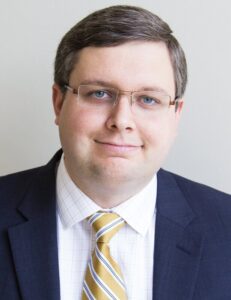
By Michael R. Heinlein
OSV News
Guest Commentary
Editor’s note: St. Elizabeth Ann Seton sought spiritual direction from Servant of God Bishop Simon Bruté during his time at St. Mary’s College in Maryland. He went on to become the first bishop of Vincennes. A bible - a personal gift to Bishop Bruté from St. Elizabeth, is on display in the Bruté museum, which is adjacent to the Minor Basilica of St. Francis Xavier in Vincennes.
My family made a recent visit to the new museum at the National Shrine of St. Elizabeth Ann Seton in Emmitsburg, Maryland. I’ve always been drawn to St. Elizabeth’s story. I remember how it fascinated me as a child that she was both a mother and a nun, not to mention the first canonized saint born in our land.
The museum has much to offer any pilgrim. I went there that day hoping to find something about her life that could inspire our oldest son as he prepares for his first Holy Communion in the spring. And, by God’s grace, something that struck me anew on this visit was the love St. Elizabeth had for the Lord’s real presence in the Blessed Sacrament.
Something that particularly stuck out to me, thanks to one of the exhibits, was how significant St. Elizabeth’s first Holy Communion was in her life. Digging into this pivotal day in her life a bit more, I came to learn that St. Elizabeth had so longed for the Lord the night ahead of her first reception of the sacrament that she lay awake “burning” with desire. And as she made the 2-mile journey so quickly to the church that next morning, she wrote, it seemed her feet barely touched the ground.
Now, this is no hyperbole by a pious biographer, but her very written words, preserved at the Maryland museum.
Remarkably, this newfound love for the Eucharist, rooted in her newfound love for the Catholic faith, came about only by providence and through much suffering. At 29, Elizabeth and her oldest child accompanied her husband to Italy in hopes his tubercular lungs might recover there. Those hopes were dashed, though, after the state quarantined them in such harsh conditions that Mr. Seton’s death was hastened.
But she was not left in despair. God burst into her life in a most amazing and transformative way. A woman of faith already, raised in the Episcopalian tradition, Elizabeth was dumbstruck by the experiences she had at the Italian estate of her husband’s friends – the Filicchis – where she became acquainted with Catholicism.
“[H]ow happy we would be,” she wrote to her sister-in-law, “if we believed what these dear souls believe, that they possess God in the sacrament and that he remains in their churches and is carried to them when they are sick.”
Her Episcopalian sensibilities maintained no strength against the power of the Eucharist. Witnessing firsthand a Eucharistic procession, Elizabeth would later recall, “I fell on my knees without thinking … and cried in an agony to God to bless me if he was there, that my whole soul desired only him.”
As I looked at the rosary St. Elizabeth received at her first Holy Communion, I wondered what might come of my son’s someday. Then, I looked at what she wrote, in her own hand, about that very day: “At last GOD IS MINE and I AM HIS.” This is the beauty of a soul who longed for total union with Christ and found it only by passing through great suffering. But once she did, she couldn’t keep it to herself. She set out to transform the world, nourished and sustained by the fullness of love contained in that tiny host.
Standing there, recalling St. Elizabeth’s first Holy Communion, I said a prayer for our son; that he might come to experience just that. And I longed to realize the full power of those words in his life and mine. That we might be so utterly transformed in the Eucharist, as was St. Elizabeth, that we might evermore long be made worthy to enter his kingdom in her footsteps.
- - -
Michael R. Heinlein is author of “Glorifying Christ: The Life of Cardinal Francis E. George, O.M.I.” and a promised member of the Association of Pauline Cooperators.
